Originally published on JUL 19, 2023
Myth: Solar and wind are cheaper than fossil fuels
Truth: Solar and wind are only cheaper than fossil fuels in at most a small fraction of situations. For the overwhelming majority of the world’s energy needs, solar and wind are either completely unable to replace fossil fuels or far more expensive.
-
We incessantly hear claims that solar and wind are cheaper than fossil fuels:
The World Economic Forum characterizes “renewables” as “the world’s cheapest source of energy”
“Renewables: Cheapest form of power” says the UN.
All such claims involve a dangerous fallacy I call “false generalization.”1
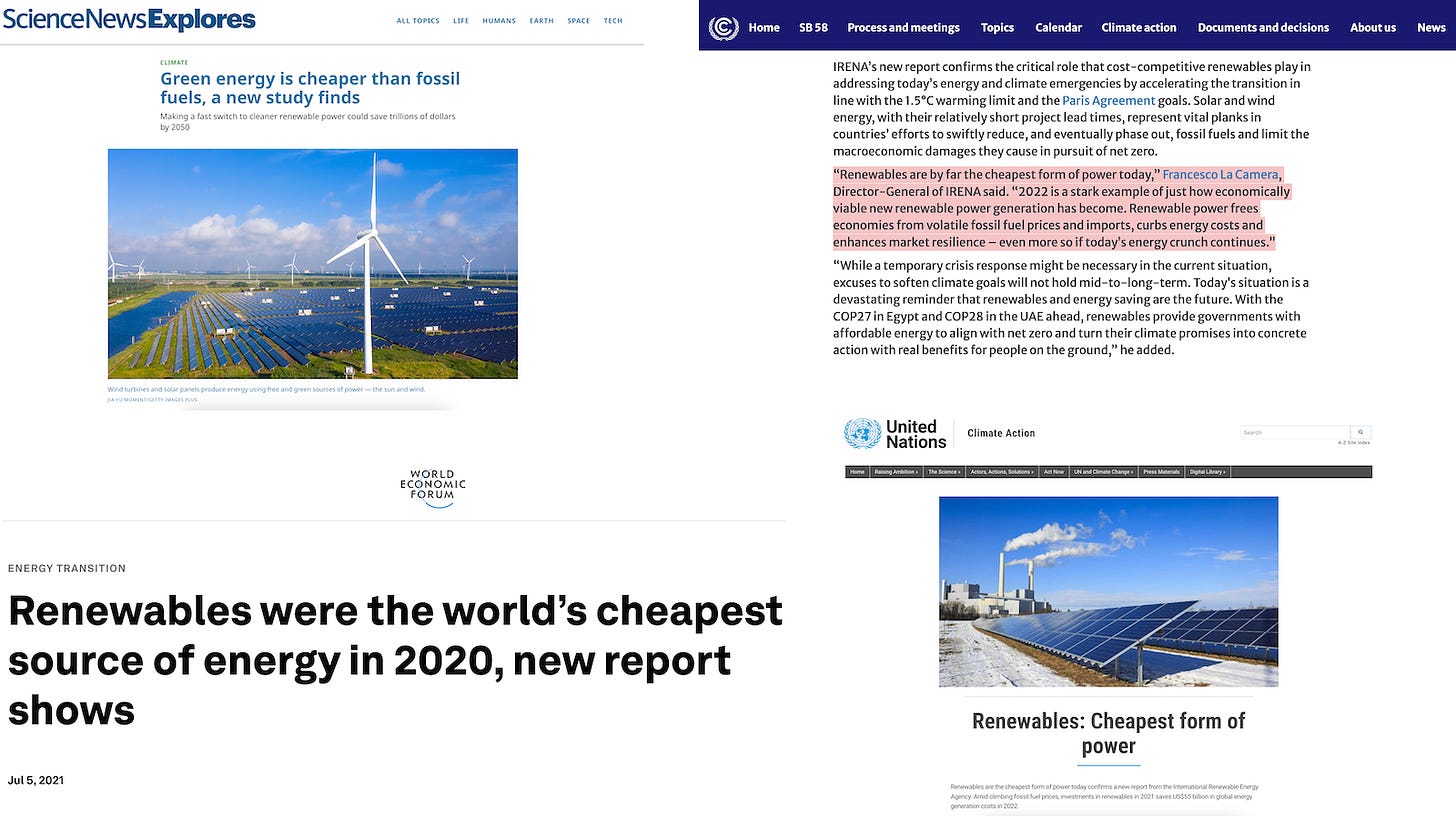
Why we should be suspicious of the pervasive claim that “solar and wind are cheaper than fossil fuels”
-
Observe that “solar and wind are cheaper than fossil fuels” is usually invoked, not to encourage competition but to justify coercive government policies to punish fossil fuel use and favor solar and wind.
-
Observe that the same people claiming “solar and wind are cheaper than fossil fuels” moved heaven and earth to demand at minimum hundreds of billions of dollars in subsidies under the “Inflation Reduction Act” for these supposedly “cheaper forms of energy.”2
-
On its face, justifying favoritism toward solar and wind by invoking their cheapness is highly suspicious. If they’re cheaper, why do they need coercive policies to throttle their fossil-fueled competitors (e.g., opposing fossil fuel investment, production, and pipelines) and reward solar and wind?
-
If a company has a TV set that’s as good as others, but cheaper, they win by selling their cheaper TVs on the market.
They don’t ask government to ban other TVs, to mandate their TV, or to give them hundreds of billions of dollars.
Truly cheaper products don’t need preferences.
-
The simple reason that advocates of solar and wind who claim they are cheaper than fossil fuels aren’t willing to outcompete fossil fuels in reality but instead demand massive government favoritism is that in the vast majority of circumstances solar and wind are not actually cheaper.
If solar and wind were cheaper, much-hated fossil fuel use wouldn’t still be growing
-
That solar and wind aren’t actually cheaper than fossil fuels should be obvious from the fact that despite enormous cultural and political hostility toward fossil fuels that makes fossil fuels artificially expensive, fossil fuel use is still growing.
-
Notably, fossil fuel growth is centered in the places that care most about cheap energy, above all China—which is using record amounts of coal to produce the solar panels and wind turbines we use. If solar and wind were cheaper they’d use solar and wind to produce solar and wind.3
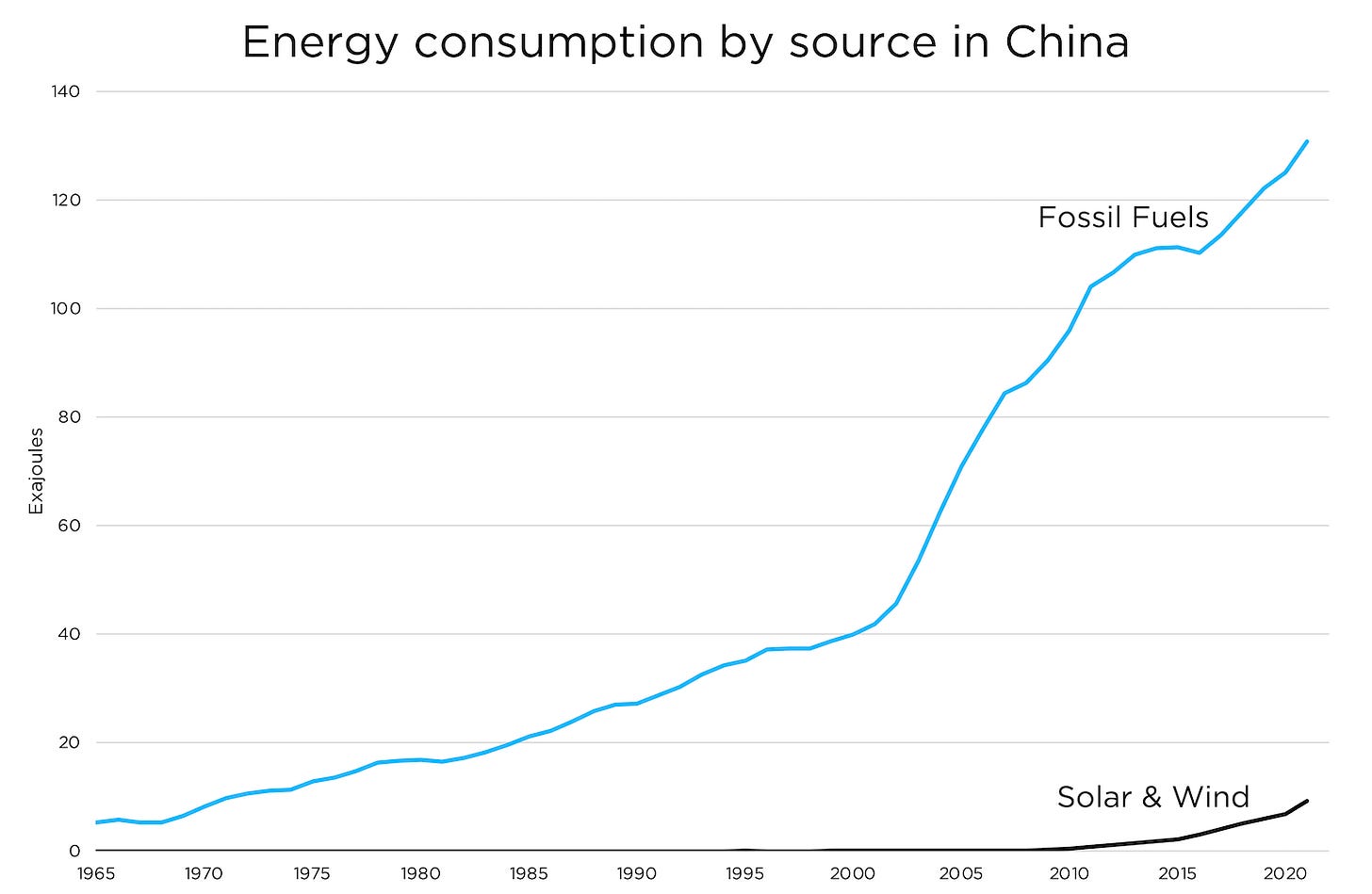
- When China is concerned about its grid reliability, it starts building more coal power plants, not more solar and wind farms, to boost supply. In late 2022, the Chinese government permitted about 2 new coal plants a week.4
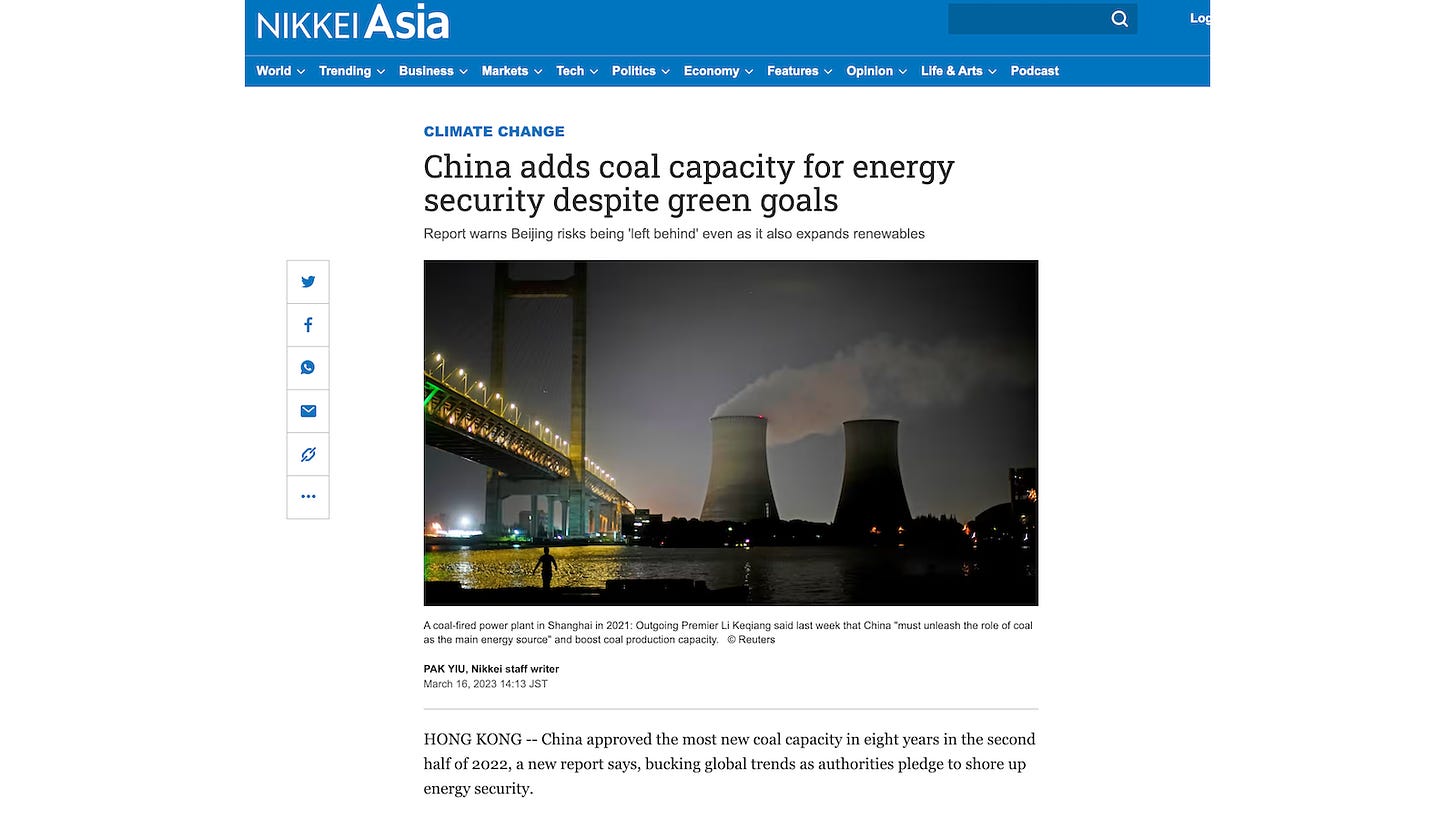
-
China, despite being the world’s leading producer of solar and wind (using coal) is also using record amounts of oil. Why not just use solar and wind instead, since “solar and wind are cheaper than fossil fuels”?
Because solar and wind aren’t cheaper. In most cases, they’re totally incapable of replacing oil.5
-
To deny the blatant reality that solar and wind cannot outcompete fossil fuels, opponents of fossil fuels use a fallacy I’ve never seen anyone identify in this context: “false generalization”—taking something that’s true in rare circumstances and falsely generalizing it to all circumstances.
The fallacy of false generalization
- Claims that solar and wind are cheaper than fossil fuels take rare use-cases in which solar and wind are, or might be, cheaper and then falsely generalize that they are always cheaper—even though they’re usually expensive or impossible.
When discussing “energy prices” we must recognize that “energy” refers to myriad specific use-cases involving different
-
Types of machines
-
Reliability requirements
-
Locations
-
Quantities
For the vast majority of use-cases solar and wind can’t compete with fossil fuels.
Types of machines, solar and wind vs. fossil fuels
-
For most types of machines we use today—which burn fossil fuels directly for transportation, industrial heat, or residential heat—solar and wind can’t come close to competing with fossil fuels. Yet they are portrayed as generally “cheaper”!
-
While it is very common to use the terms “energy” and “electricity” interchangeably, the fact is that the vast majority of machines in the world today don’t run on electricity—they run on the direct burning of fossil fuels, because that is the only or cheapest way to run them.
-
The top 4 types of machines, by energy use, are: transportation machines that burn fossil fuels, all machines that use electricity—using multiple fuels, (including 60% fossil fuels globally), industrial heat machines that burn fossil fuels, and residential/commercial heat machines that burn fossil fuels.6
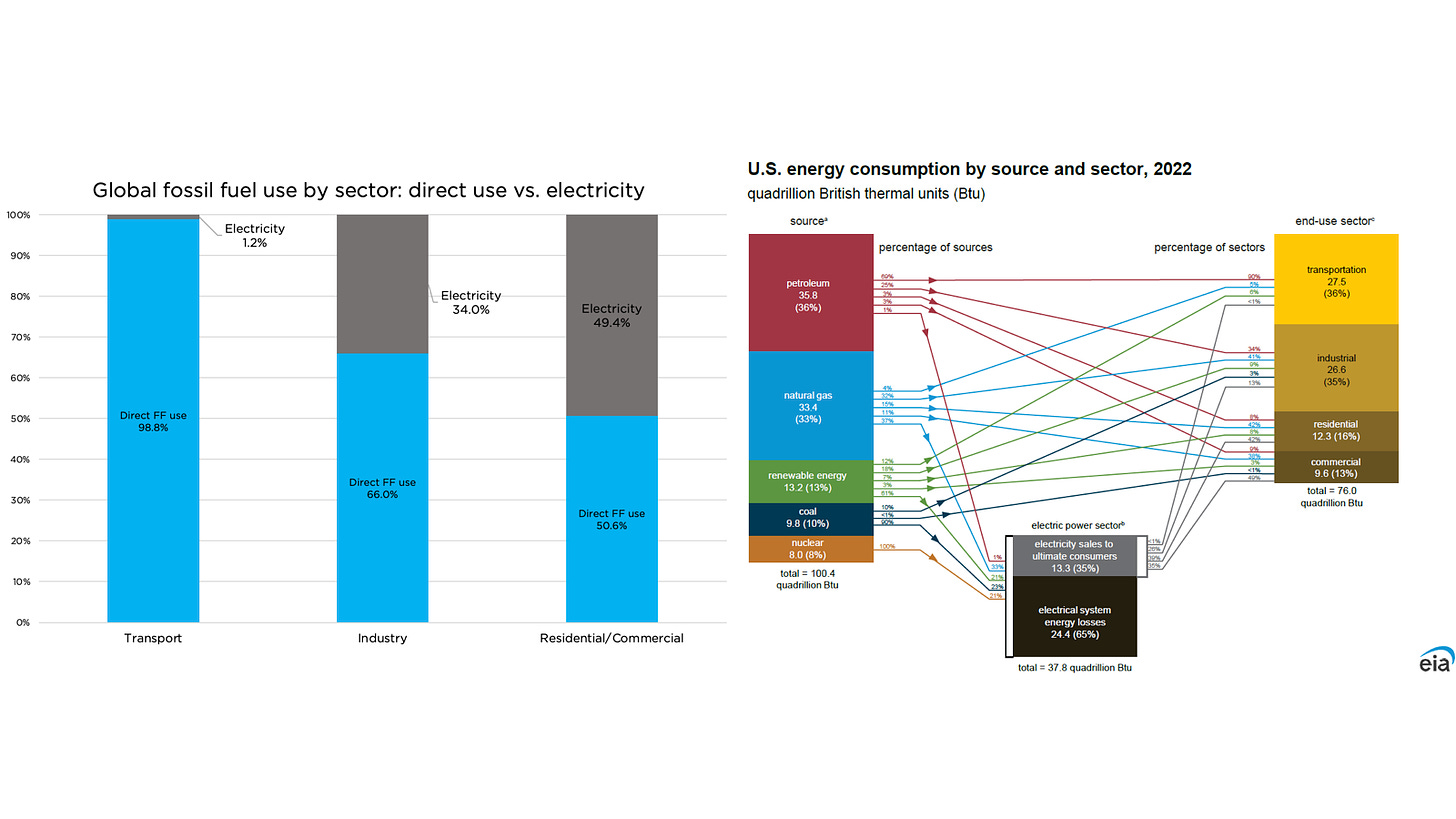
-
The reason the vast majority of the world’s machines today use the direct burning of fossil fuels, instead of electricity (from any source) is cost-effectiveness. Direct burning is the only way to power many transport machines, and the cheapest way to power many heating machines.
-
Oil, the densest fossil fuel, is a highly-concentrated yet stable energy source. This makes it uniquely good for transport, which benefits from as much energy per pound as possible. In some cases, e.g., airplanes and cargo ships, there’s no real electric alternative to oil at any cost.
-
Solar and wind advocates sometimes promote battery-powered ships and airplanes, dishonestly ignoring the fact that these are costly showcases incapable of cost-effective transcontinental flights and long-distance transport, which is the lifeblood of our global economy.7
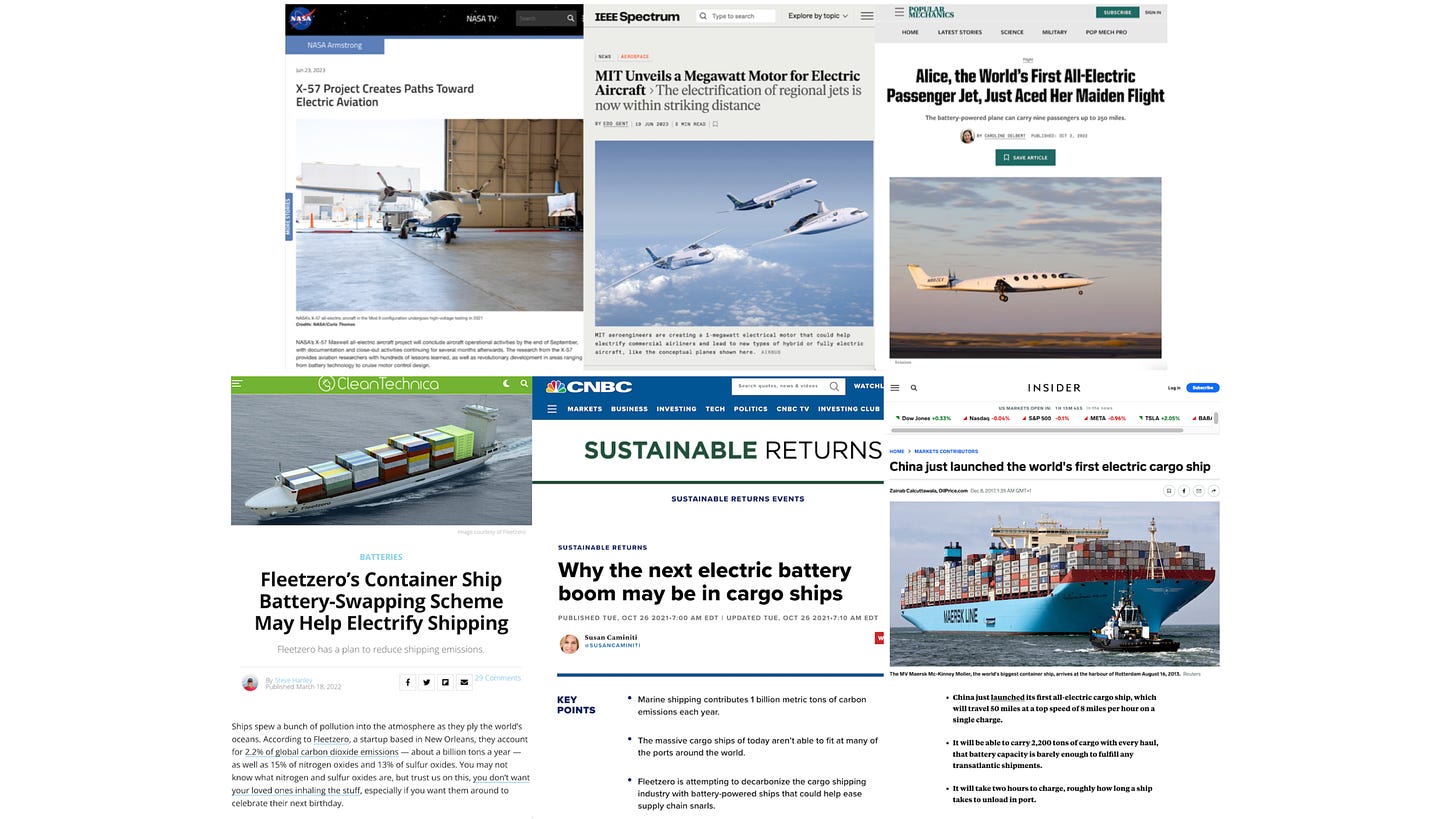
-
For airplanes and cargo ships, solar and wind aren’t just not cheaper than fossil fuels,” they are infinitely expensive because they cannot do what fossil fuels can do.
E.g., they can't fly 200 people from LA to London or move 400 million lbs of cargo from Korea to Brazil at 25 MPH.
-
While the high levels of heat industry requires (e.g., for steel-making) and the lower levels of heat residential or commercial areas require can be provided by electricity, it is often far cheaper to burn fossil fuels directly vs. going from fuel to electricity to heat.
-
Even if solar and wind were somewhat cheaper than fossil fuels at providing electricity—which they rarely are, due to unreliability—they still would be expensive or impossible as replacements for fossil fuel heating and transport.
Yet they’re portrayed as generally “cheaper”!
-
Anyone who promotes the idea of solar and wind being generally cheaper than fossil fuels for “energy” as such—when solar and wind electricity is obviously expensive and/or impossible for fossil fuels’ non-electricity uses—is ignorant and/or incompetent and/or dishonest, and should be ignored.8
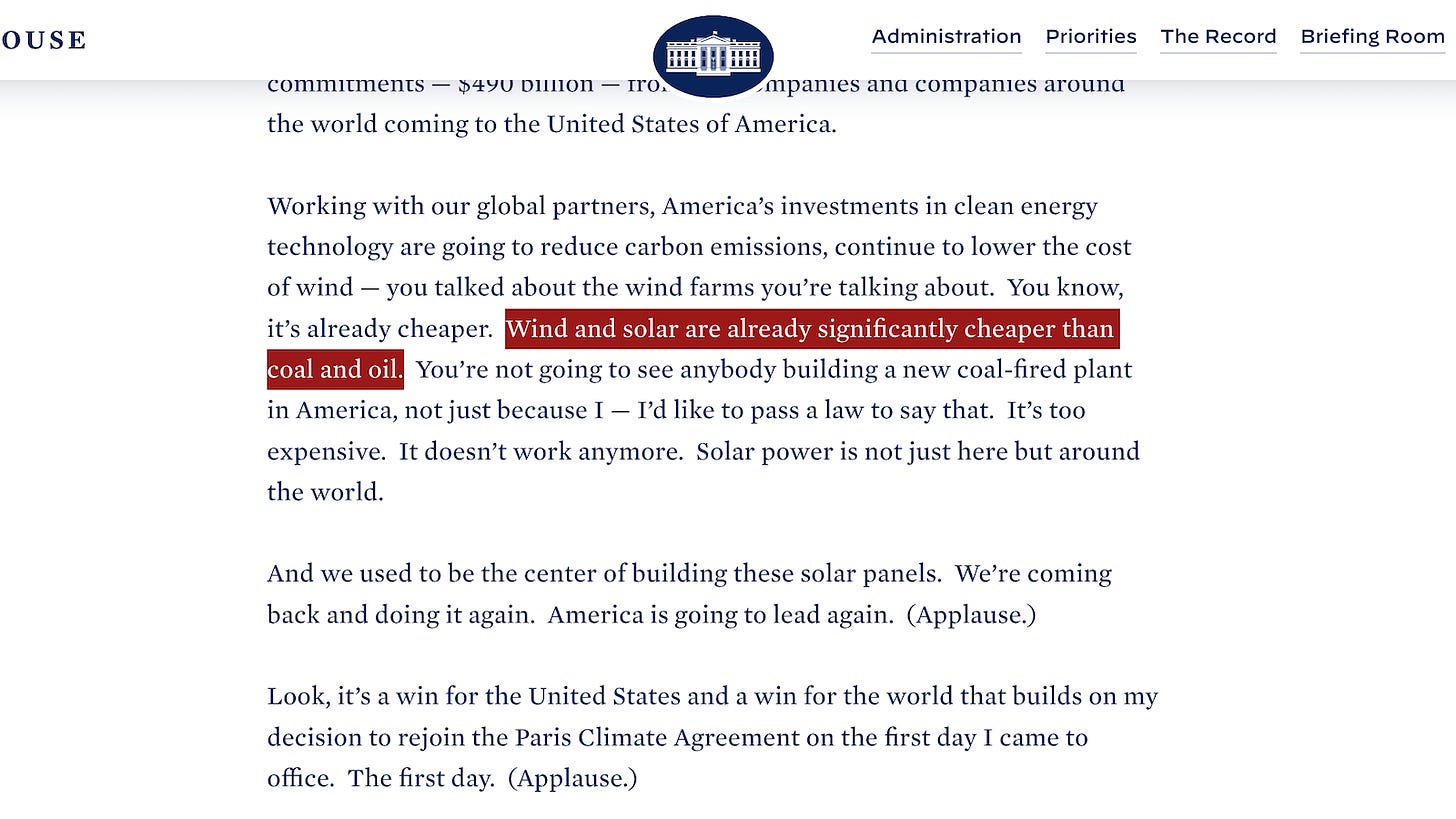
Reliability requirements, solar and wind vs. fossil fuels
-
Solar and wind clearly can’t outcompete fossil fuels for transport and heat.
And solar and wind can’t even outcompete fossil fuels for most electricity due to reliability requirements.
Yet the irrelevant price of unreliable solar and wind is used to claim cheapness!
-
Reliability is the ability to provide energy when needed, in the amount needed. While some energy uses have relatively low reliability requirements—e.g., a pool heater doesn’t need to work at an exact time—most have high reliability requirements. Including most electricity use.
-
While someone living a very modest off-grid lifestyle might not have rigorous reliability requirements for electricity, a modern electric grid absolutely does. To operate safely the grid must precisely, reliably control the supply of electricity to meet ever-changing demand.
-
Because reliability is paramount to electricity, when comparing electricity prices—e.g., fossil fuels vs. solar and wind—we must only compare prices for reliable electricity. Yet it’s common to compare the price of reliable fossil fuel electricity to unreliable solar and wind electricity.
-
Many instances of “solar and wind are cheaper than fossil fuels” not only ignore the non-electricity uses where solar and wind are totally uncompetitive, they use a bogus metric called “Levelized Cost of Energy” (LCOE) which by its own definition ignores the issue of reliability!9
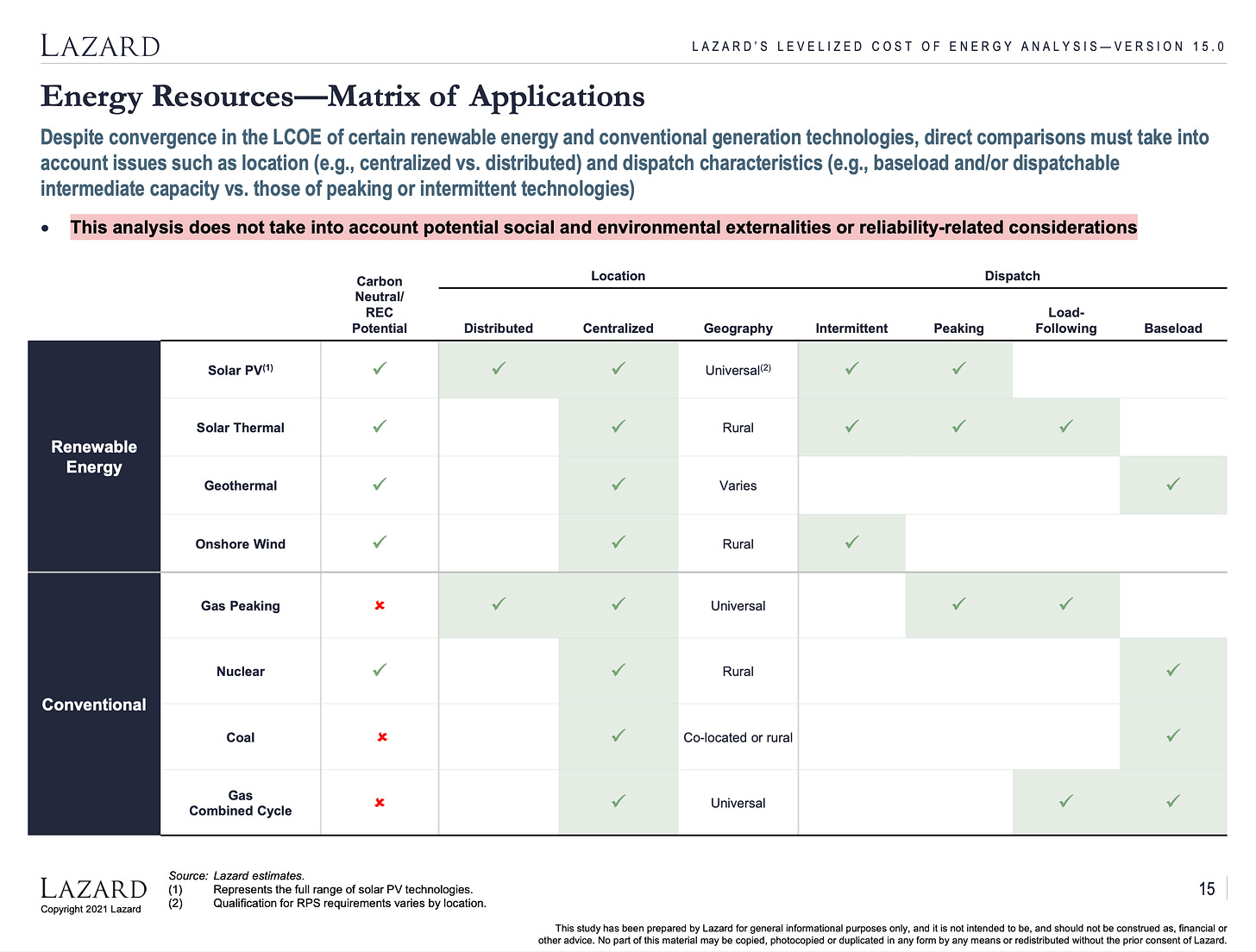
-
The constantly-used Lazard “Levelized Cost of Energy” (LCOE) analysis explicitly says “This analysis does not take into account… reliability-related considerations.”
Such an analysis is worthless. But it is used widely to misrepresent solar and wind as cheap.10
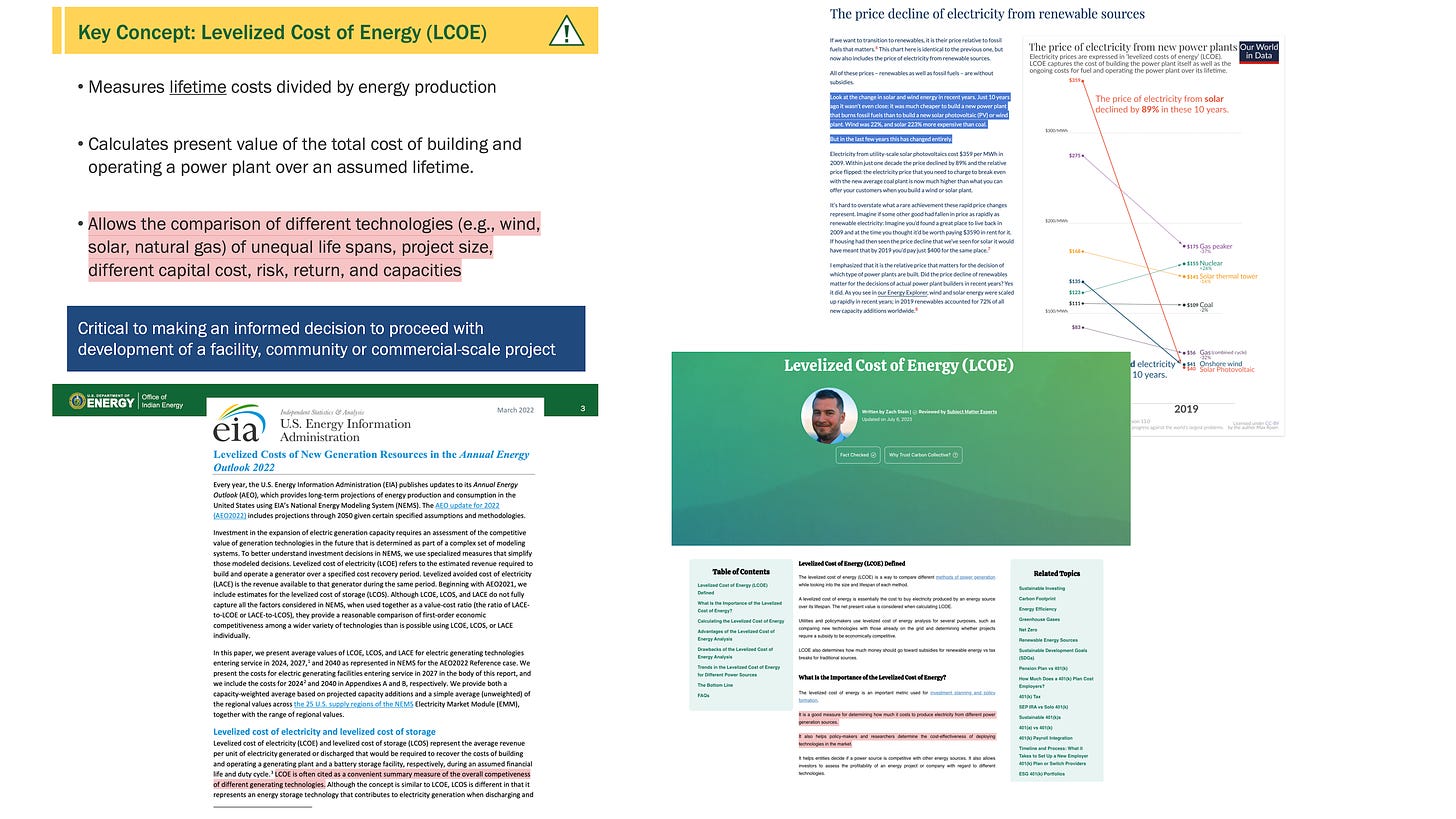
-
The basic cost problem with solar and wind is their inherent unreliability. To use them to deliver reliable electricity we need to also pay for a reliable life-support grid (e.g., gas plants). This is very often wasteful; it’s usually cheaper just to pay for a reliable grid.
-
When we look at large regions that use solar and wind a lot, we see a trend of price increases and/or reliability decreases, because solar and wind add costs to the reliable grids needed to support them—and if you try to save money by shrinking the reliable grid you get reliability problems.11
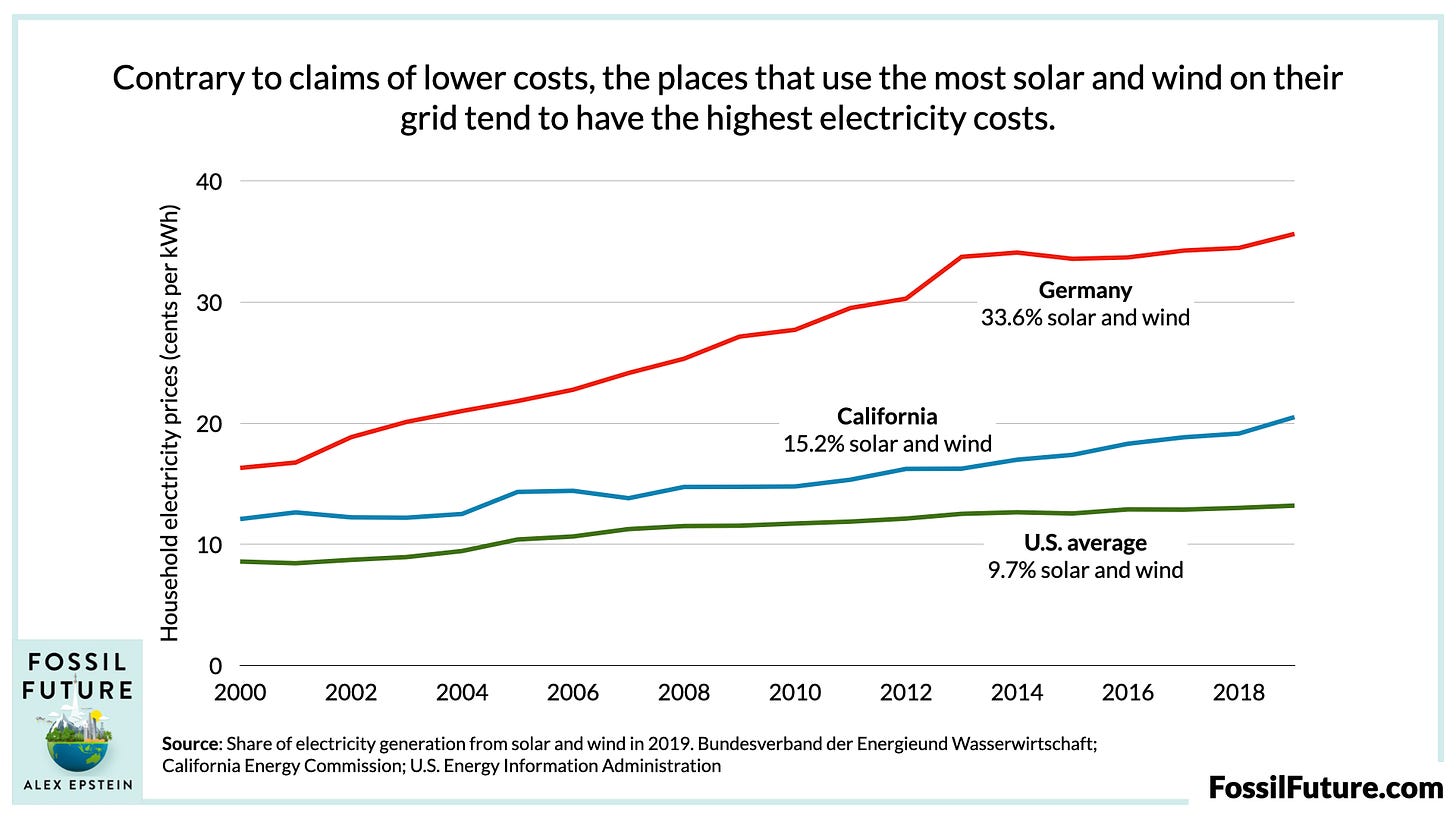
-
Instead of honestly looking at the full cost of solar and wind compared to fossil fuels for providing reliable electricity—which looks very bad for solar and wind most of the time—opponents of fossil fuels claim “solar and wind are cheaper” by comparing the cost of unreliable solar and wind with reliable fossil fuel electricity.
-
Happily, the energy community is starting to recognize the fallacy of conflating the price of reliable fossil fuels with the price of unreliable solar and wind. Even “LCOE” villain Lazard is now pointing out that solar and wind plus even modest storage are more costly than fossil fuels.12
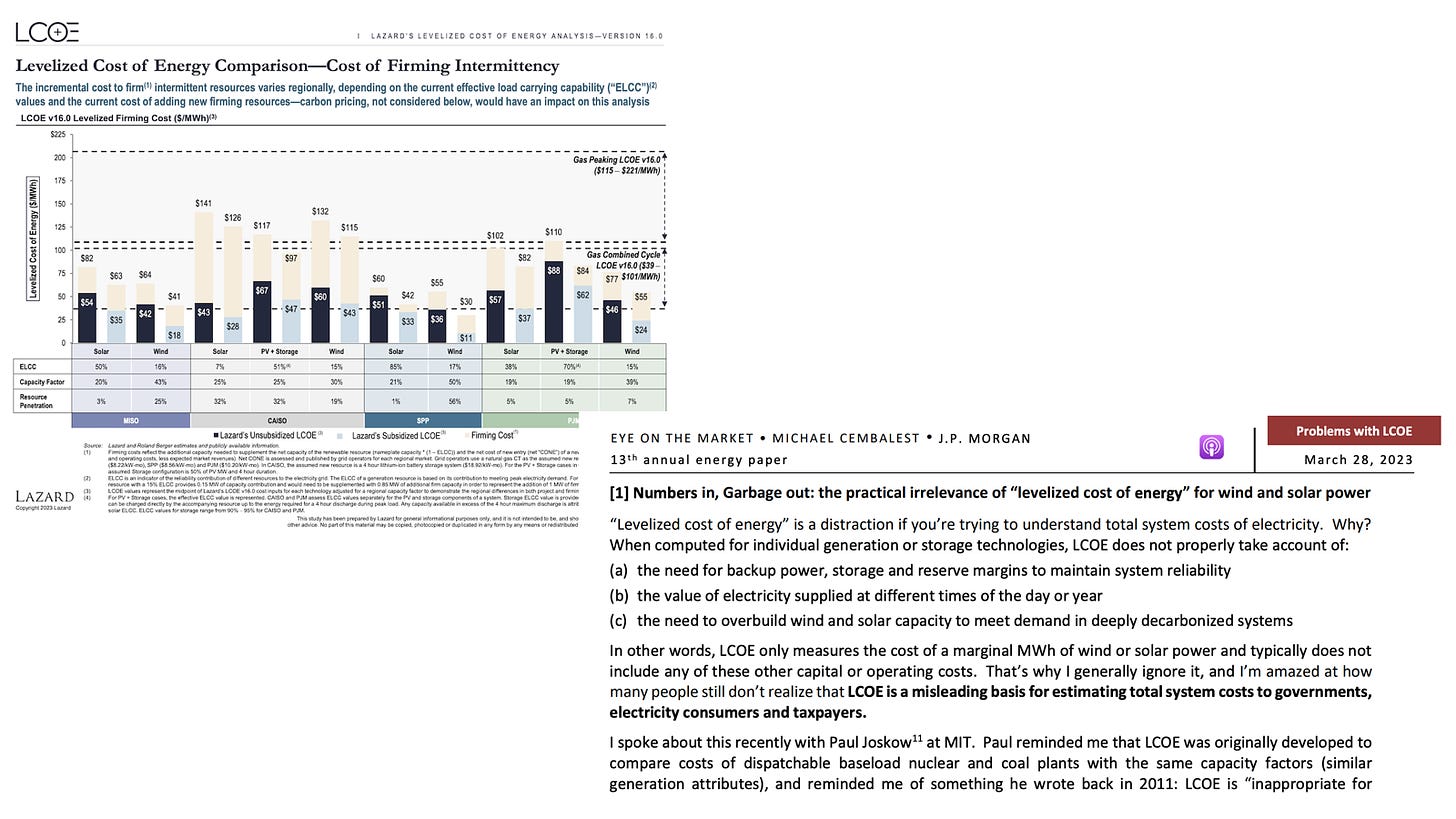
-
While it's good that some energy leaders are questioning price comparisons between fossil fuels and unreliable solar and wind, they are still not recognizing the huge full costs of solar and wind given that they can go near-zero at any given time and thus require near-100% life support.
-
In the rare situations where electricity reliability requirements are low, solar and wind can be cheaper than fossil fuels.
But it’s deeply dishonest to falsely generalize “solar and wind are cheaper than fossil fuels” given that for most reliability requirements solar and wind are far more expensive.
Location, solar and wind vs. fossil fuels
-
Even by solar and wind’s low standards of versatility and reliability, they perform poorly in most locations.
Yet the sunniest or windiest areas are used to make general rosy claims about solar and wind.
-
Every use of energy takes place in a certain location and was produced by processes taking place in multiple locations.
Location always affects the cost of energy. E.g., nearby or piped natural gas is often the cheapest solution while ocean-transported gas often isn’t.
-
Because location has such a significant effect on the price of energy, one must be cautious in generalizing from a source of energy being cheapest in one location to it being cheapest everywhere. E.g., natural gas power has often been cheaper than coal in the US but not in Asia.
-
Solar and wind are incredibly location-sensitive. Although nowhere do they have the reliability of fossil fuels, let alone versatility, they perform at their best in consistently sunny (e.g., desert-like areas including Southern California) and windy areas (such as Iowa or West Texas).13
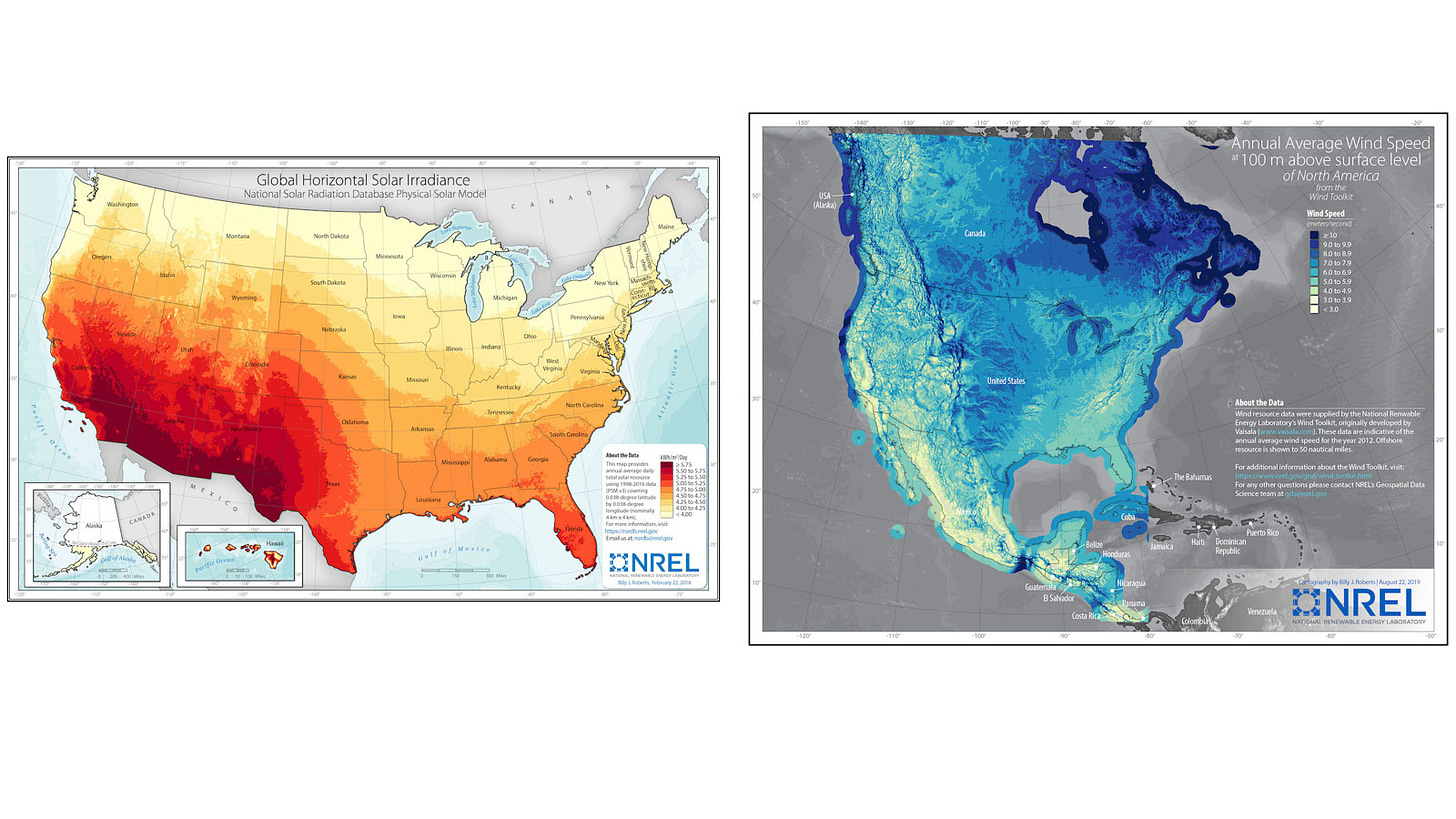
- It’s easy to underestimate how rare the best solar and wind resources are, especially in the US where we have a disproportionate amount of the world’s best. But observe the many regions of the world that are weak in one or the other, sometimes both (e.g., much of South America).14
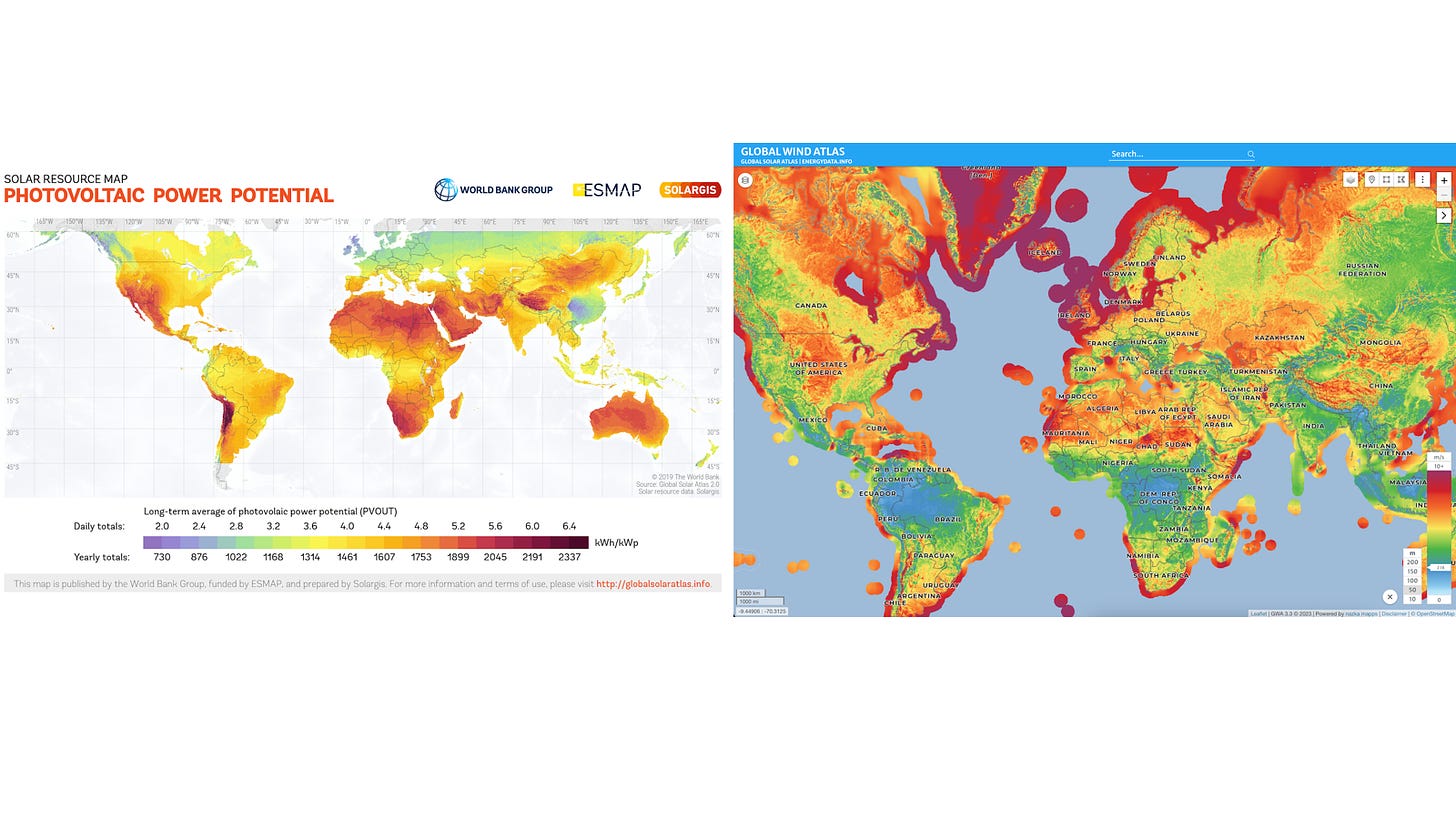
-
While most forms of energy are highly location-sensitive in where they originate (e.g., many places lack oil and coal) many are dense enough that they can be transported fairly easily to most places around the world. But not sunlight and wind, which aren’t portable fuels.
-
Transporting solar and wind electricity from source to consumption often requires expensive, long-distance transmission lines that involve a lot of difficult development—made especially difficult by “green” activists—and that lose significant energy over distance.15
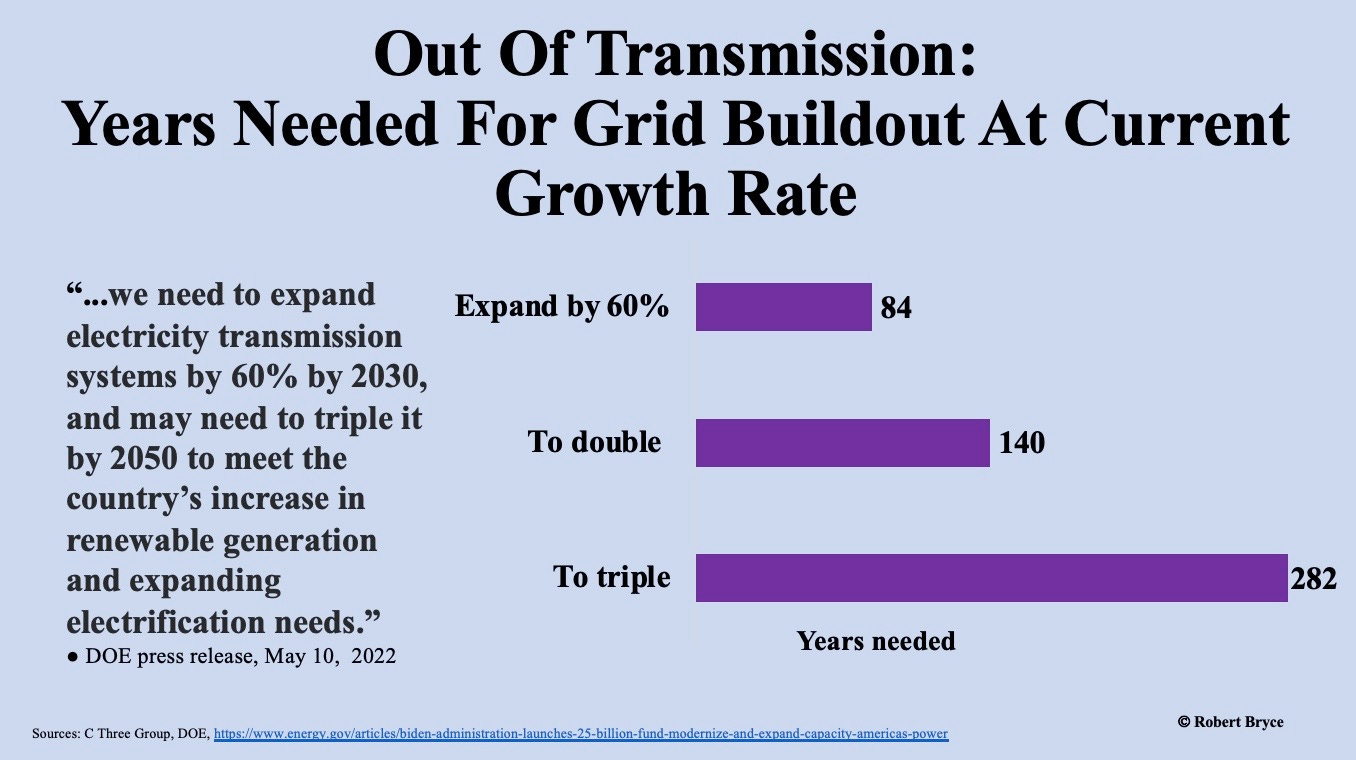
-
Solar and wind also have a location challenge of requiring large amounts of land due to their low “energy density.” This makes them very problematic for large cities, where they can’t possibly support the population.
-
Solar and wind’s large land requirements, which often exist in scenic places, attract opposition from potential neighbors and from the impact-hating “green” movement.
This is captured by Robert Bryce’s “Renewable Rejection Database.”16
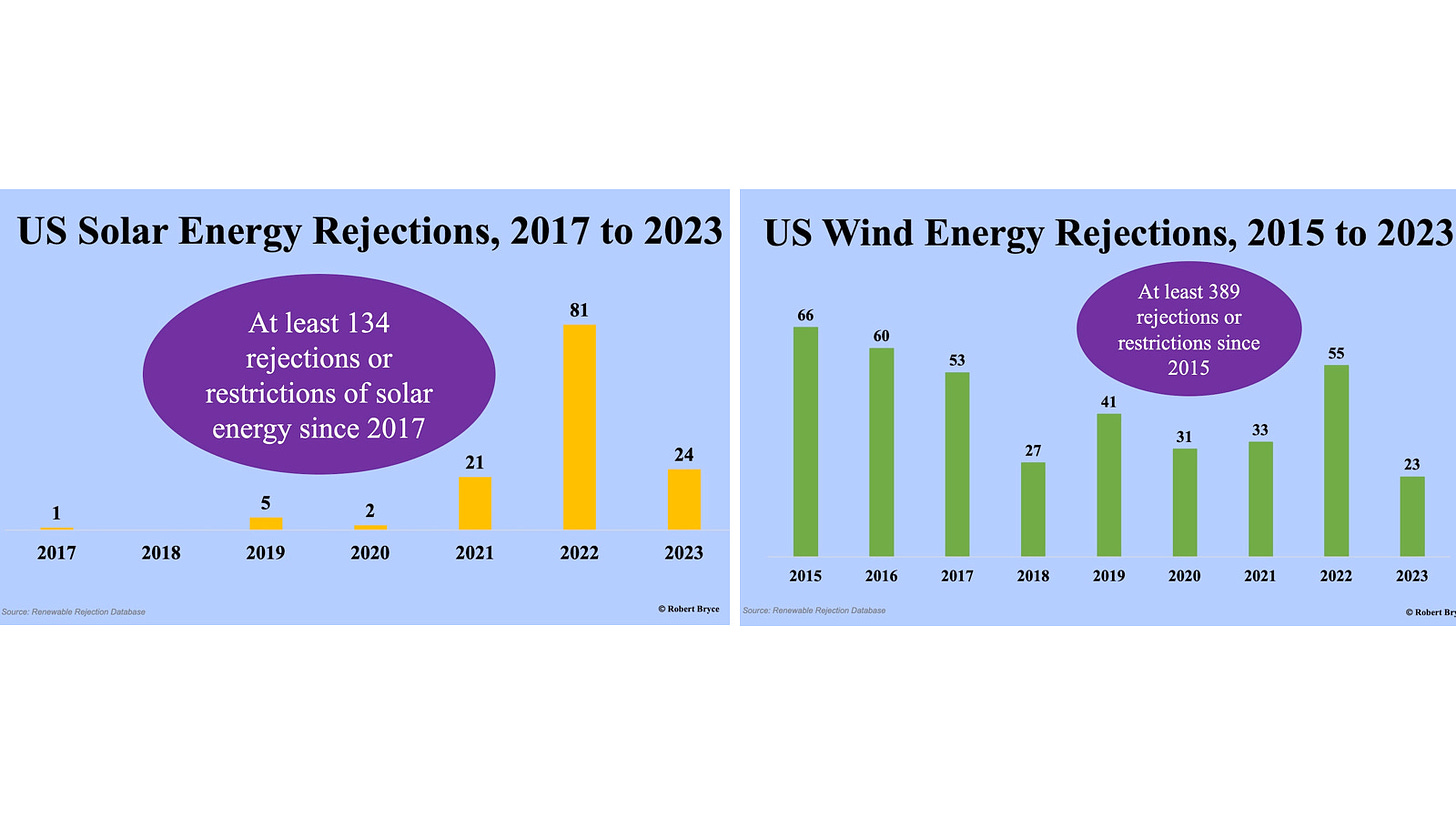
- Many “solar and wind are cheaper” claims, in addition to only looking at electricity and ignoring reliability, take prices or performance from places solar and wind perform best—e.g., Southern California or Iowa—and falsely generalize that to the vast majority of places that lack these solar and wind resources.17
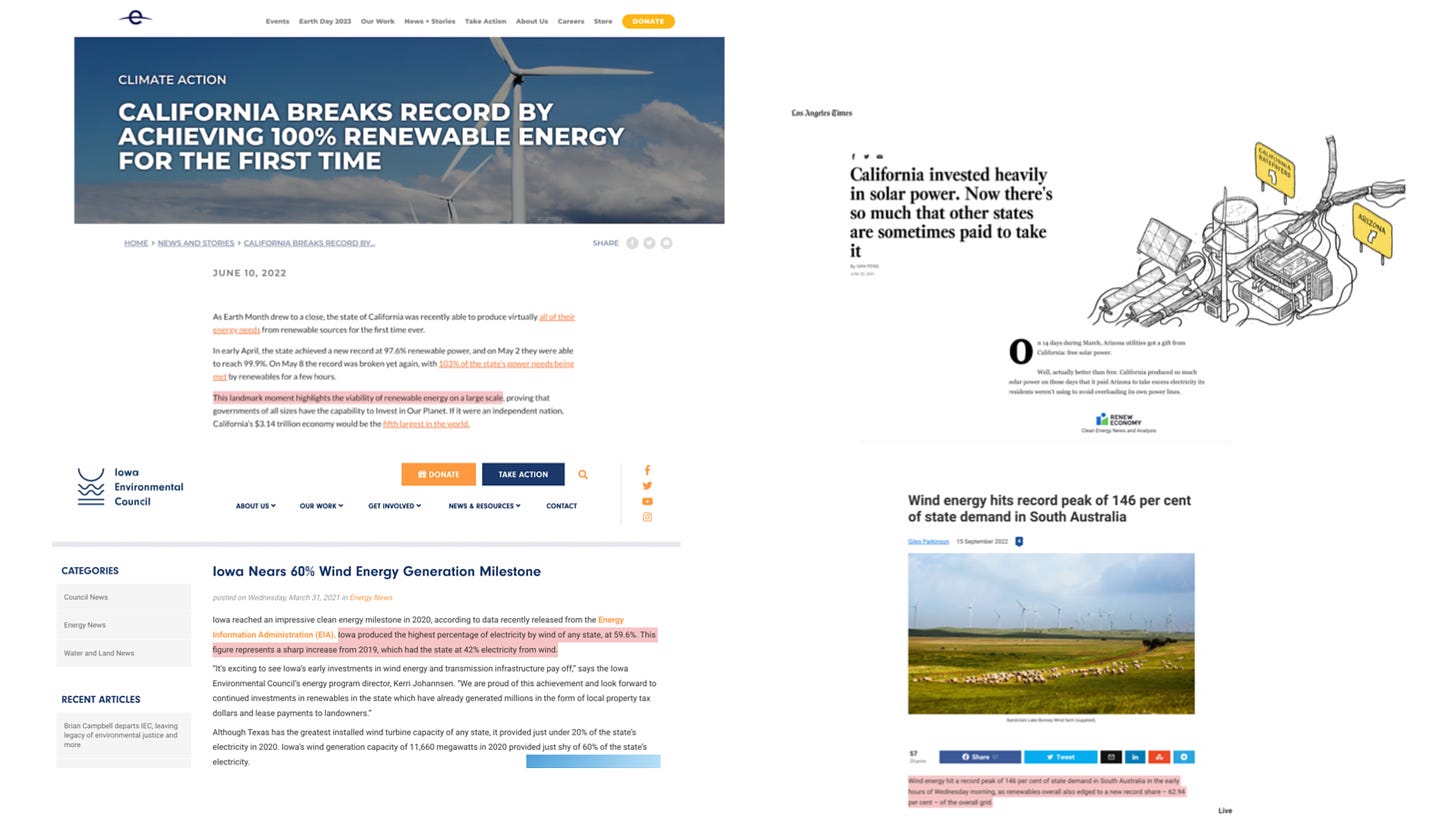
-
Whenever you hear someone rave about Southern California or Iowa or West Texas in making some general laudatory claim about solar and wind, you can be sure that the person is trying to dupe you through false generalization from one location to every location.
-
Note that false generalization from one location to all locations is also common for geothermal energy.
Geothermal is successfully used in Iceland as a major source of heat and electricity.
This is often falsely generalized to claim that it can be used everywhere.
-
Geothermal is used dominantly in Iceland because Iceland is uniquely conducive to it.
It has an unusual combination of
- heat reservoirs providing heat or hot steam relatively near the surface.
And
2) a very small populationMost places don’t have this combination.18
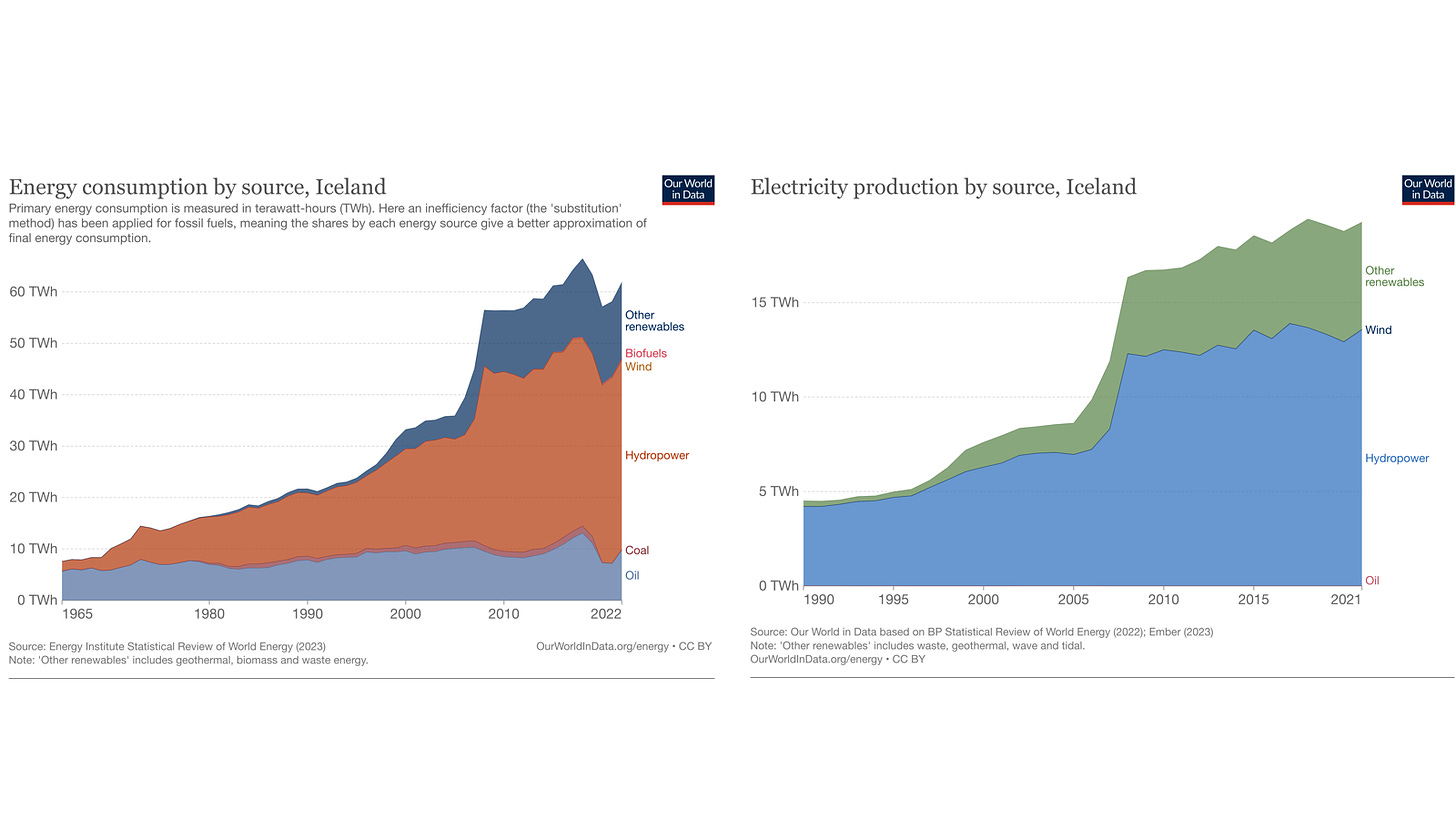
Scale, solar and wind vs. fossil fuels
-
In addition to all their other problems, solar and wind have mining requirements that make them expensive to scale quickly.
Yet today’s solar and wind prices are falsely generalized to be the same or lower if solar and wind scale on a crazy “net-zero-by-2050” timetable.
-
Whenever we talk about the price of energy, we need to recognize that the price of energy can change dramatically depending on the scale it is being used on.
Sometimes larger scales can reduce prices (economies of scale) and sometimes larger scales can increase prices (diseconomies of scale).
-
A classic example of a form of energy that goes up in price past a certain scale is wood. Wood is for many people the cheapest source of energy because it is naturally available in their surroundings.
However, once use exceeds the scale of naturally-available wood, new wood requires more expensive tree planting and harvesting, and the price goes up.
-
Some aspects of solar and wind scale well. In particular, as more firms have worked on producing solar and wind in larger quantities, the efficiency of producing panels and turbines has increased. This has been one factor in driving (unreliable) solar and wind prices down.
-
Given that solar and wind are advocated as the main sources of energy to be used to attempt to replace fossil fuels on a 2050 timetable, they face an enormous, even catastrophic scale problem: the problem of scaling on an artificially fast timetable.
-
Scaling on an artificially fast timetable is a major “diseconomy of scale.” When a government or other entity demands that something be available in much larger quantities well before markets and infrastructure can develop to do so cheaply, shortages and price increases are inevitable.
-
Plans to scale solar and wind involve more than doubling the supply of half a dozen major mined materials per decade. For perspective, I know of no example, ever, of even one major mined mineral doubling that fast, even with pro-development governments—let alone today's anti-development governments.19
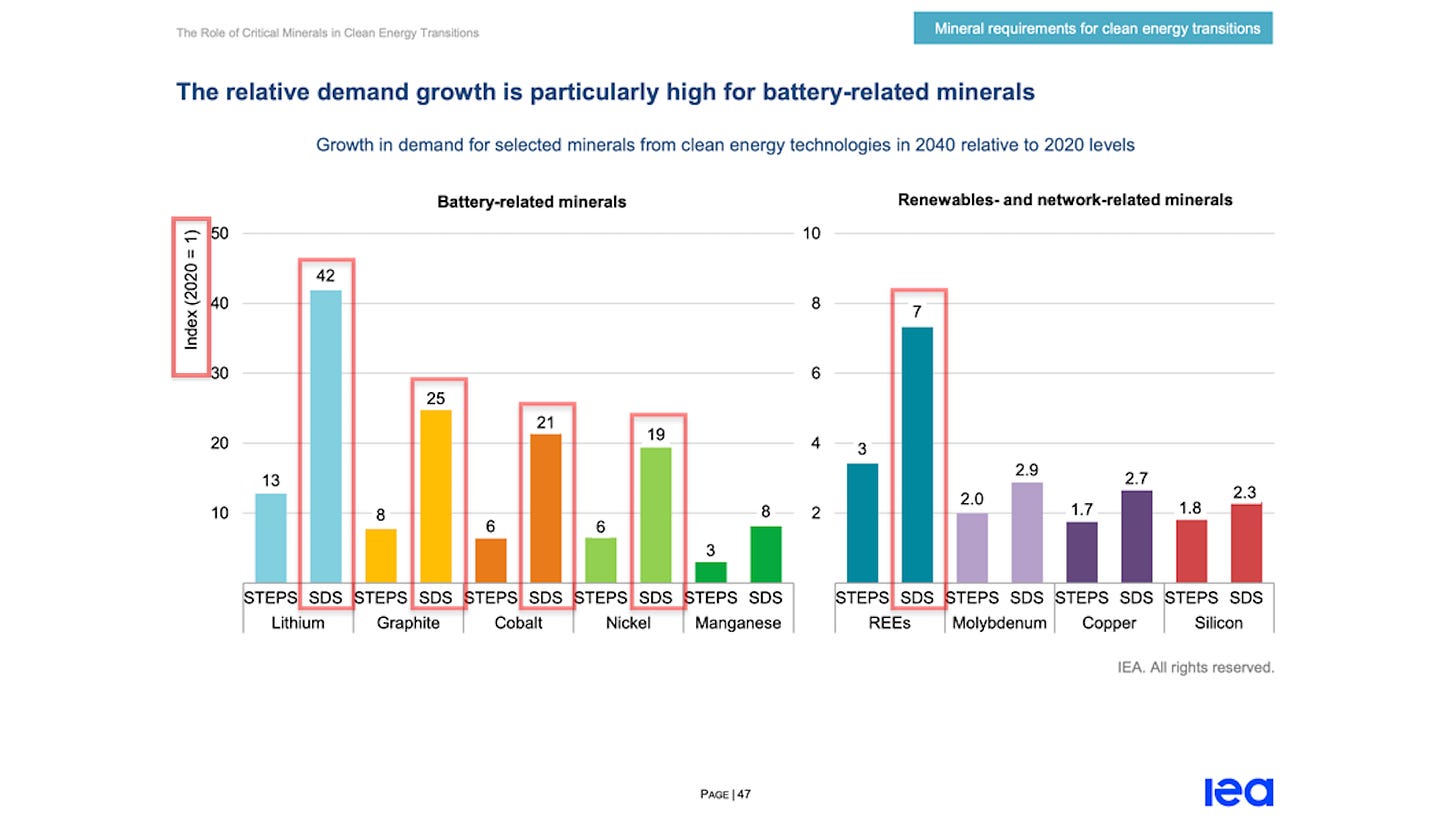
-
Even relatively mild increases in demand for critical minerals have led to scaling issues and cost increases in recent years—reversing a trend of falling prices that solar and wind advocates pretended would last forever.
What will rapid scaling and “green” anti-mining policies do?20
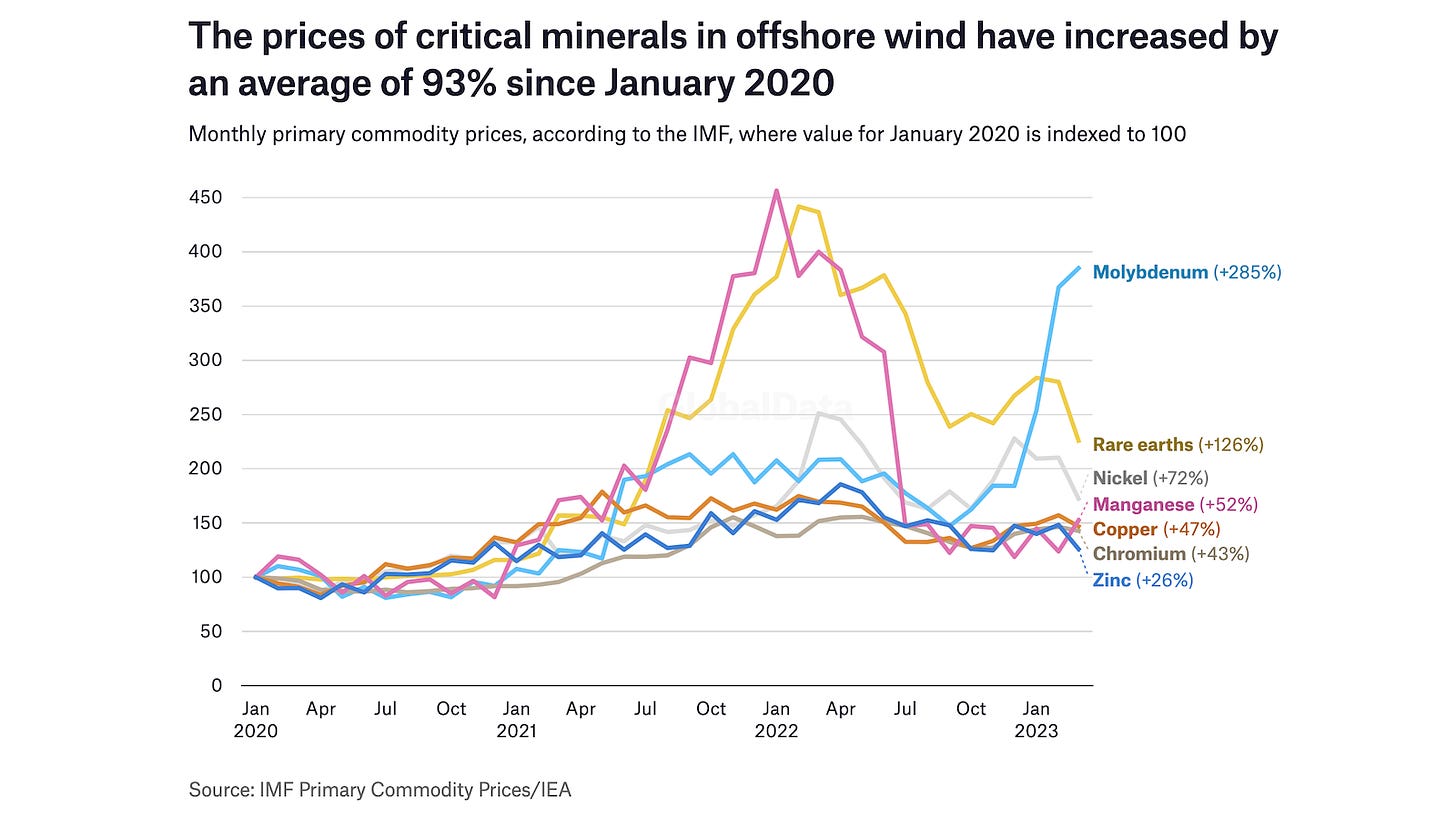
-
Given the absurdly fast, arbitrary artificial timetable being suggested for solar and wind—net-zero by 2050—one cannot talk about solar and wind prices without acknowledging the catastrophic scaling price increases involved. And yet advocates treat today’s prices as guaranteed to decline!
-
Assuming today’s solar and wind prices will stay the same or decrease, regardless of how quickly they are scaled, is yet another false generalization by their advocates: falsely generalizing pricing from a current small scale to a very rapid large scale.
-
Summary: Solar and wind advocates falsely claim “solar and wind are cheaper” by falsely generalizing from the small minority of situations in which this is true to the vast majority where it’s completely false due to machine type, reliability requirements, location, and/or scale.
-
Solar and wind advocates love to take a rare energy use-case in which solar and wind may be cheaper—such as powering midday and afternoon air-conditioning in Dubai—and falsely generalize that “solar and wind are cheaper” for all machines, reliability requirements, and locations on a global scale.
-
Saying “solar and wind are cheaper” because they might be cheaper at powering midday and afternoon air-conditioning in Dubai is like a CEO saying “teenage labor is cheaper” because it can fill some mailroom positions.
Yet such false generalization is driving our energy policy.
References
-
ScienceNewsExplores - Green energy is cheaper than fossil fuels, a new study finds
WEF - Renewables were the world’s cheapest source of energy in 2020, new report shows
UN Climate Change - Renewable Power Remains Cost-Competitive amid Fossil Fuel Crisis
-
Nikkei Asia - China adds coal capacity for energy security despite green goals
Global Energy Monitor - China permits two new coal power plants per week in 2022↩
-
NASA - X-57 Project Creates Paths Toward Electric Aviation
Popular Mechanics - Alice, the World’s First All-Electric Passenger Jet, Just Aced Her Maiden Flight
Clean Technica - Fleetzero’s Container Ship Battery-Swapping Scheme May Help Electrify Shipping
CNBC - Why the next electric battery boom may be in cargo ships
Business Insider - China just launched the world's first electric cargo ship↩
-
The White House - Remarks by President Biden on Bidenomics | Chicago, IL↩
-
Carbon Collective - Levelized Cost of Energy (LCOE)
Our World in Data - Why did renewables become so cheap so fast?
U.S. DOE Office of Indian Energy - Levelized Cost of Energy (LCOE)
U.S. EIA - Levelized Costs of New Generation Resources in the Annual Energy
-
German household electricity prices have more than doubled since 2000 when the modern renewable energy law started to massively incentivize solar and wind capacity on the German grid.
BDEW Strompreisanalyse April 2023The average US household price in 2021 was $0.1366 per kWh.
U.S. Energy Information Administration Electric Power Annual table 5a↩ -
Lazard - 2023 Levelized Cost Of Energy+
J.P. Morgan - Growing Pains: The Renewable Transition in Adolescence↩
-
Climate Action - CALIFORNIA BREAKS RECORD BY ACHIEVING 100% RENEWABLE ENERGY FOR THE FIRST TIME
Iowa Environmental Council - Iowa Nears 60% Wind Energy Generation Milestone
Renew Economy - Wind energy hits record peak of 146 per cent of state demand in South Australia↩
-
IEA - The Role of Critical Minerals in Clean Energy Transitions
“Meeting such unprecedented mineral demands will require opening far more mines than now exist, and far faster than at any time in history. (The global average time from the qualification of a property to bringing a new mine into operation is 16 years.)”
Mark Mills - The “Energy Transition” Delusion A Reality Reset↩ -
Energy Monitor - Data shows how the cost of energy transition minerals has soared since 2020↩
